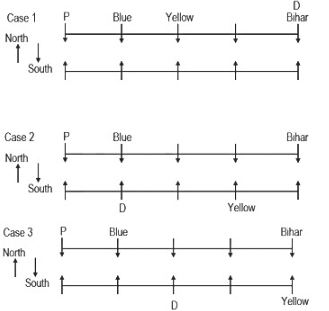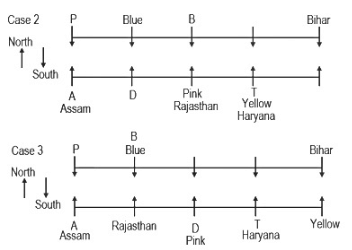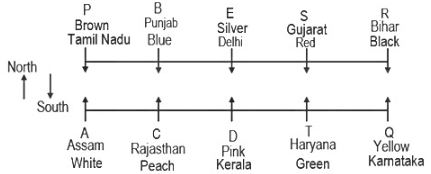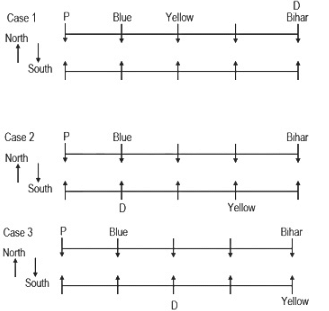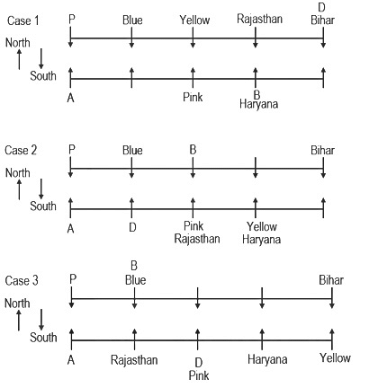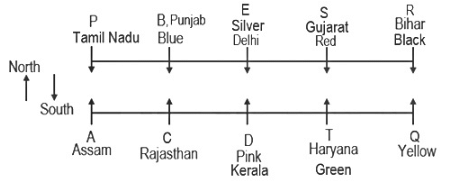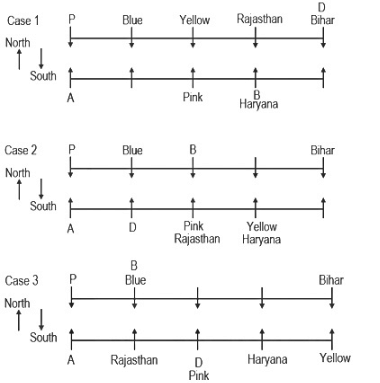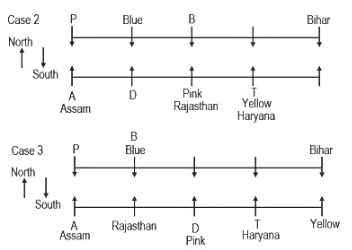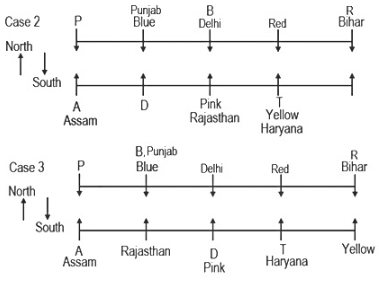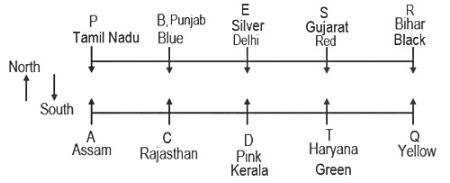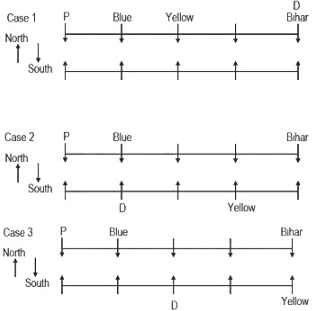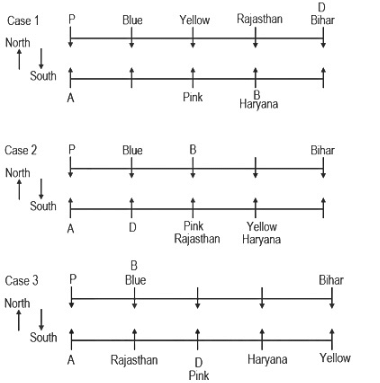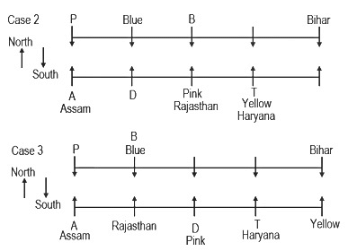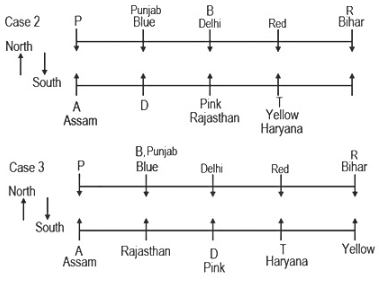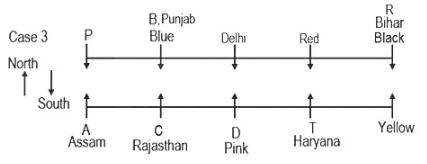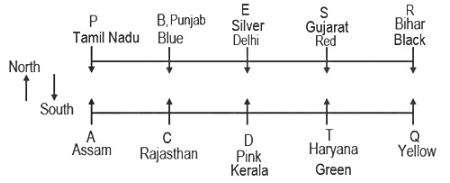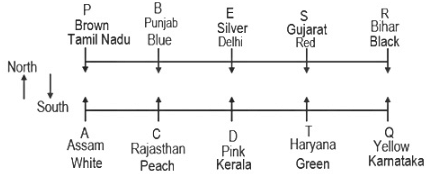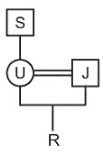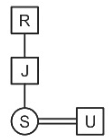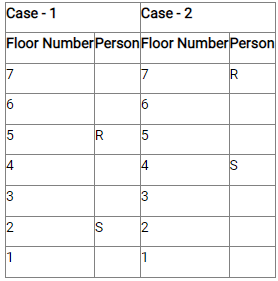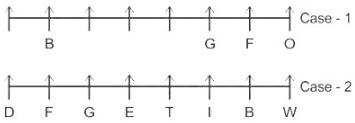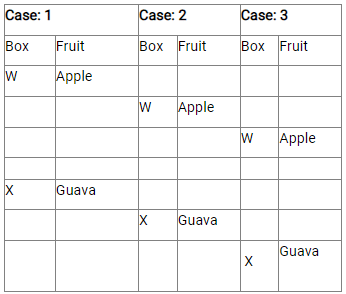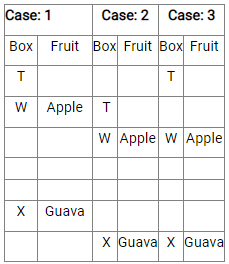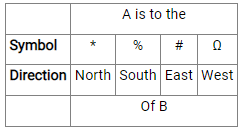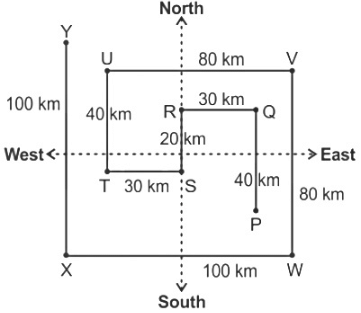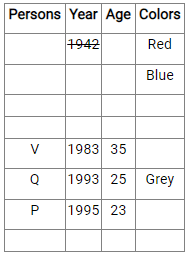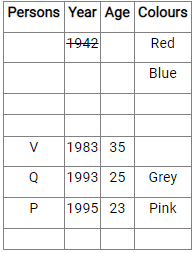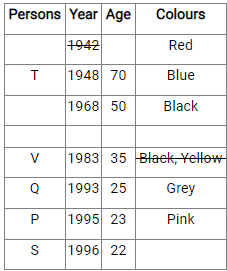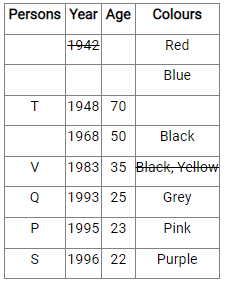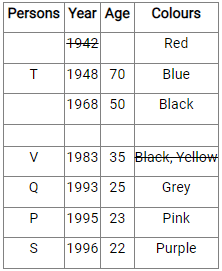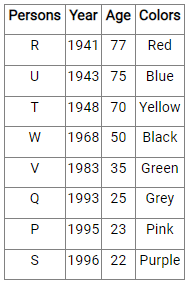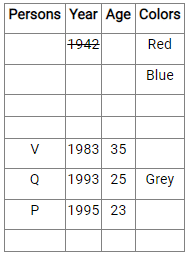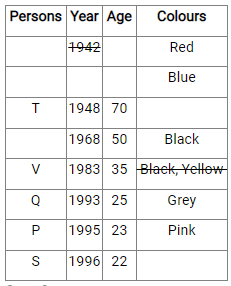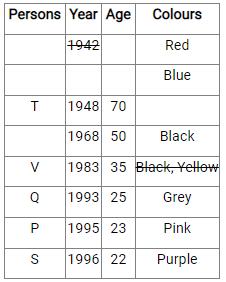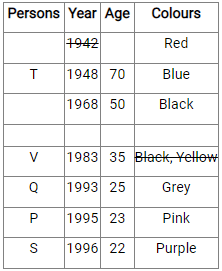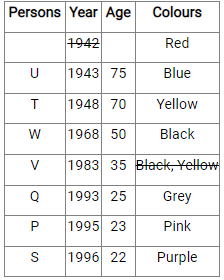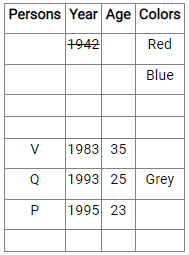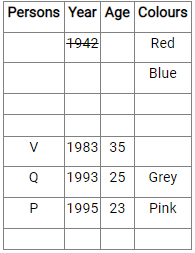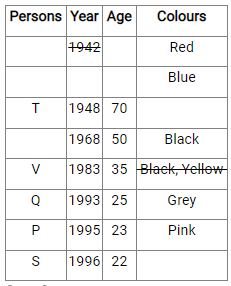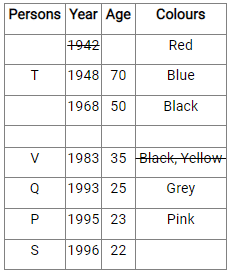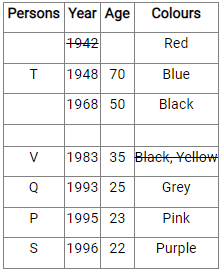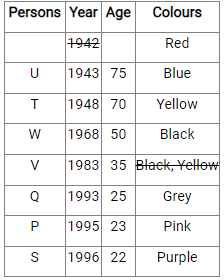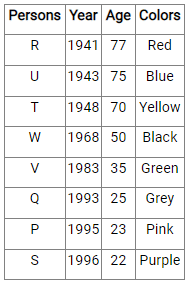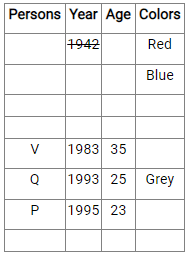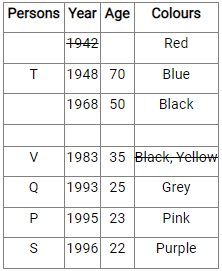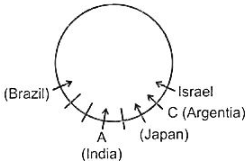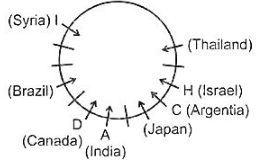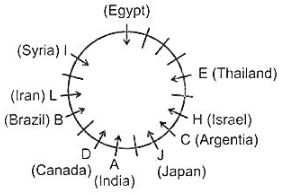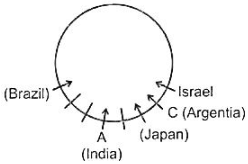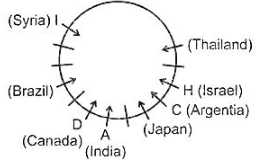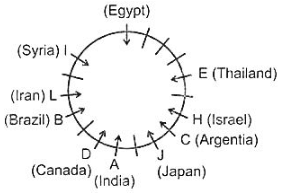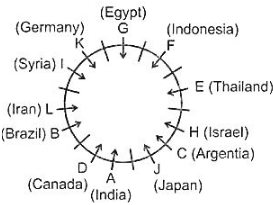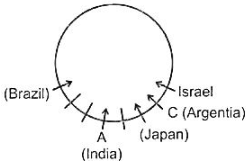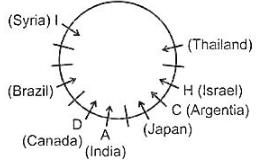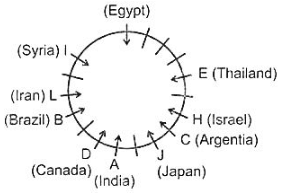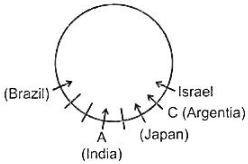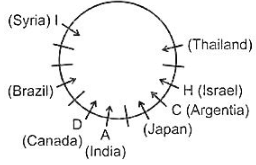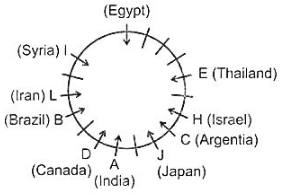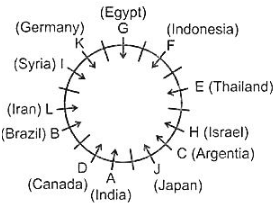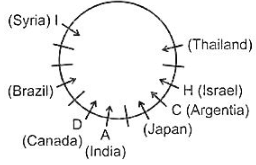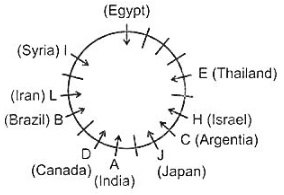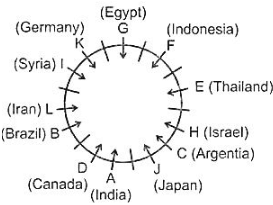IBPS RRB PO (Scale 1) Mains Mock Test - 1 - Bank Exams MCQ
30 Questions MCQ Test - IBPS RRB PO (Scale 1) Mains Mock Test - 1
Directions: Read the following information carefully and answer the question that follow:
Ten people - A, B, C, D, E, P, Q, R, S and T are sitting in two rows with five persons in each row, not necessarily in the same order. Each person in row one is facing south and each person in other row is facing north. Each person in row one faces a person from the other row. Each of them belongs to different states - Delhi, Tamil Nadu, Gujarat, Rajasthan, Punjab, Bihar, Karnataka, Haryana, Assam and Kerala. All of them likes different colours - Red, Green, Blue, White, Peach, Black, Yellow, Brown, Silver and Pink. The one who belongs to Bihar is sitting third to the left of blue. P is not facing north but is sitting immediate right of the one who likes blue. The one who likes yellow is sitting second to the right of D. P neither likes yellow nor facing to D. The one who belongs to Haryana is facing the one who is sitting third to the left of P. A is sitting third to the left of the one who belongs to Haryana. Only one person is sitting between A and the one who likes pink. B is facing to the one who belongs to Rajasthan. D is an immediate neighbour of the one who belongs to Rajasthan. T is sitting third to the right of the one who belongs to Assam. T is not sitting at any of the extreme ends. Two persons are sitting between R and the one who belongs to Punjab. P doesn’t belong to Punjab. R is not an immediate neighbour of T. The one who belongs to Delhi is an immediate neighbour of the one who likes red. R is an immediate neighbour of the one who likes red. C is facing the one who is sitting third to the right of the one who likes black. A doesn’t like black. The one who belongs to Tamil Nadu is sitting second to the right of the one who likes silver. E is an immediate neighbour of the one who belongs to Gujarat. Q is sitting second to the right of the one who belongs to Kerala. S is facing the one who likes Green. The one who likes white is sitting immediate left of the one who likes peach.
Q. Who among the following likes peach colour?
Directions: Read the following information carefully and answer the question that follow:
Ten people - A, B, C, D, E, P, Q, R, S and T are sitting in two rows with five persons in each row, not necessarily in the same order. Each person in row one is facing south and each person in other row is facing north. Each person in row one faces a person from the other row. Each of them belongs to different states - Delhi, Tamil Nadu, Gujarat, Rajasthan, Punjab, Bihar, Karnataka, Haryana, Assam and Kerala. All of them likes different colours - Red, Green, Blue, White, Peach, Black, Yellow, Brown, Silver and Pink. The one who belongs to Bihar is sitting third to the left of blue. P is not facing north but is sitting immediate right of the one who likes blue. The one who likes yellow is sitting second to the right of D. P neither likes yellow nor facing to D. The one who belongs to Haryana is facing the one who is sitting third to the left of P. A is sitting third to the left of the one who belongs to Haryana. Only one person is sitting between A and the one who likes pink. B is facing to the one who belongs to Rajasthan. D is an immediate neighbour of the one who belongs to Rajasthan. T is sitting third to the right of the one who belongs to Assam. T is not sitting at any of the extreme ends. Two persons are sitting between R and the one who belongs to Punjab. P doesn’t belong to Punjab. R is not an immediate neighbour of T. The one who belongs to Delhi is an immediate neighbour of the one who likes red. R is an immediate neighbour of the one who likes red. C is facing the one who is sitting third to the right of the one who likes black. A doesn’t like black. The one who belongs to Tamil Nadu is sitting second to the right of the one who likes silver. E is an immediate neighbour of the one who belongs to Gujarat. Q is sitting second to the right of the one who belongs to Kerala. S is facing the one who likes Green. The one who likes white is sitting immediate left of the one who likes peach.
Q. Who among the following belongs to Karnataka?
Directions: Read the following information carefully and answer the question that follow:
Ten people - A, B, C, D, E, P, Q, R, S and T are sitting in two rows with five persons in each row, not necessarily in the same order. Each person in row one is facing south and each person in other row is facing north. Each person in row one faces a person from the other row. Each of them belongs to different states - Delhi, Tamil Nadu, Gujarat, Rajasthan, Punjab, Bihar, Karnataka, Haryana, Assam and Kerala. All of them likes different colours - Red, Green, Blue, White, Peach, Black, Yellow, Brown, Silver and Pink. The one who belongs to Bihar is sitting third to the left of blue. P is not facing north but is sitting immediate right of the one who likes blue. The one who likes yellow is sitting second to the right of D. P neither likes yellow nor facing to D. The one who belongs to Haryana is facing the one who is sitting third to the left of P. A is sitting third to the left of the one who belongs to Haryana. Only one person is sitting between A and the one who likes pink. B is facing to the one who belongs to Rajasthan. D is an immediate neighbour of the one who belongs to Rajasthan. T is sitting third to the right of the one who belongs to Assam. T is not sitting at any of the extreme ends. Two persons are sitting between R and the one who belongs to Punjab. P doesn’t belong to Punjab. R is not an immediate neighbour of T. The one who belongs to Delhi is an immediate neighbour of the one who likes red. R is an immediate neighbour of the one who likes red. C is facing the one who is sitting third to the right of the one who likes black. A doesn’t like black. The one who belongs to Tamil Nadu is sitting second to the right of the one who likes silver. E is an immediate neighbour of the one who belongs to Gujarat. Q is sitting second to the right of the one who belongs to Kerala. S is facing the one who likes Green. The one who likes white is sitting immediate left of the one who likes peach.
Q. P belongs to which state?
Directions: Read the following information carefully and answer the question that follow:
Ten people - A, B, C, D, E, P, Q, R, S and T are sitting in two rows with five persons in each row, not necessarily in the same order. Each person in row one is facing south and each person in other row is facing north. Each person in row one faces a person from the other row. Each of them belongs to different states - Delhi, Tamil Nadu, Gujarat, Rajasthan, Punjab, Bihar, Karnataka, Haryana, Assam and Kerala. All of them likes different colours - Red, Green, Blue, White, Peach, Black, Yellow, Brown, Silver and Pink. The one who belongs to Bihar is sitting third to the left of blue. P is not facing north but is sitting immediate right of the one who likes blue. The one who likes yellow is sitting second to the right of D. P neither likes yellow nor facing to D. The one who belongs to Haryana is facing the one who is sitting third to the left of P. A is sitting third to the left of the one who belongs to Haryana. Only one person is sitting between A and the one who likes pink. B is facing to the one who belongs to Rajasthan. D is an immediate neighbour of the one who belongs to Rajasthan. T is sitting third to the right of the one who belongs to Assam. T is not sitting at any of the extreme ends. Two persons are sitting between R and the one who belongs to Punjab. P doesn’t belong to Punjab. R is not an immediate neighbour of T. The one who belongs to Delhi is an immediate neighbour of the one who likes red. R is an immediate neighbour of the one who likes red. C is facing the one who is sitting third to the right of the one who likes black. A doesn’t like black. The one who belongs to Tamil Nadu is sitting second to the right of the one who likes silver. E is an immediate neighbour of the one who belongs to Gujarat. Q is sitting second to the right of the one who belongs to Kerala. S is facing the one who likes Green. The one who likes white is sitting immediate left of the one who likes peach.
Q. T likes which colour?
There are five trees of different heights. Tree A is taller than tree C, which is shorter than tree D. Tree B is the shortest of all the trees. Tree E is taller than tree A but not the tallest one. Then, which of the following trees is the tallest among all?
Directions: Read the following information carefully to answer this question.
A × B means 'A is the wife of B',
A ÷ B means 'A is the father of B'.
Q. Which of the following expression means R is the paternal grandfather of S?
How many pairs of letters are there in the word " CASTRAPHONE" which have as many letters between them in the word as in the alphabet?
Directions: In the question below a statement followed by two assumptions numbered I and II has been given. An assumption is something supposed or taken for granted. You are required to consider the statement and the following assumptions and decide which of the assumptions and decide which of the assumptions is implicit in the statement.
Statement: In spite of the bad quality of food, employees have not complained.
Assumptions:
I. Generally employees complain.
II. Complaints improve quality.
Directions: Question below consists of a question and three statements numbered I, II and III given below it. You have to decide whether the data provided in the statements are sufficient to answer the question.
Seven friends - S, T, R, F, G, J and V are living on different floors of a seven store building having seven floors numbered one to seven (The ground floor is numbered 1, the floor above it is numbered 2 and so on and the topmost floor is numbered 7). Who is staying immediately below G’s floor?
Statement I: R lives on one of the odd numbered floors above floor 3. And only two people live between the R and S.
Statement II: Only one person lives between S and G, who is staying below T and above S. T does not stay on the top floor.
Statement III: V stays above F but below J.
Directions: Question below consists of a question and three statements numbered I, II and III given below it. You have to decide whether the data provided in the statements are sufficient to answer the question.
Eight people – O, G, E, T, F, J, W and B are sitting in a row facing north, but they are not necessarily seated in the same order. Who is sitting second to the left of J?
Statement I: Neither F nor B is sitting at the extreme ends of the row. But four people are sitting between F and B.
Statement II: F is the immediate neighbour of G and O, who is sitting at one of the extreme ends of the row.
Statement III: J is sitting second to the left of W, who is sitting at one of the extreme end of the row. E is sitting to the immediate left of T.
Directions: Question below consists of a question and three statements numbered I, II and III given below it. You have to decide whether the data provided in the statements are sufficient to answer the question.
Seven boxes S, T, U, V, W, X, and Y are kept one above the other. They all contain different fruits namely: Mango, Apple, Guava, Banana, Pear, Cherry, and Grape but not necessarily in the same order. There are three boxes between W and X. Box S is below box W, which contains Apple. The box which contains Mango is just above the box of Pears. Box U is above box V. Which box is just below the box of Banana?
Statement I: Box W is above box X, which contains Guava. The box of Banana is above the box of Grape.
Statement II: Box U not contain Pears but is above the box X. Box X is below the box S. Box T is above the box W. The box of Banana is below the box of Pears.
Statement III: Box T contains Cherry and is above box Y, which contains Mango. The box of Guava is immediately above the box of Grape.
Directions: Study the following information carefully and answer the questions given below:
If,
A * B (67km) means A is 56 km north of B.
A % B (45km) means A is 34 km south of B.
A # B (58km) means A is 47 km east of B.
A Ω B (39km) means A is 28 km west of B.
If, P % Q (51km); Q # R (41km); R * S (31km); S # T (41km); T % U (51 km); U Ω V (91km); V * W (91km); W # X (111km); X % Y (111km)
Q. What is the shortest distance between R and P?
Directions: Study the following information carefully and answer the questions given below:
If,
A * B (67km) means A is 56 km north of B.
A % B (45km) means A is 34 km south of B.
A # B (58km) means A is 47 km east of B.
A Ω B (39km) means A is 28 km west of B.
If, P % Q (51km); Q # R (41km); R * S (31km); S # T (41km); T % U (51 km); U Ω V (91km); V * W (91km); W # X (111km); X % Y (111km)
Q. What is the direction of U with respect to R?
Directions: Read the following information carefully to answer this question.
A $ B means A is mother of B, A # B means A is father of B, A @ B means A is husband of B, A % B means A is daughter of B.
Q. If G $ M @ K, how is K related to G?
Directions: The question consists of two statements, an assertion and a reason. The student must first determine whether each statement is true. Choose the appropriate option, after reading the two statements carefully.
Assertion (A): Nuclear demilitarization is essential, to save the future of mankind.
Reason (R): Nuclear weapons are weapons of mass destruction.
Directions: Study the following information carefully and answer the given question.
When a letter/number/symbol arrangement machine is given an input line of letters/ numbers/ symbol, it arranges them by following a certain rule. Following is an illustration of input and rearrangement.
Read the following information and answer the questions that follow:
INPUT: J @ 4 F # 5 V $ 3 S % 8 L & 3 M ) 9 X ( 3 S ≤ 2
Step 1: J @ 5 F # 4 V $ 8 S % 3 L & 9 M ) 3 X ( 2 S ≤ 3
Step 2: J # 5 F @ 4 V % 8 S $ 3 L ) 9 M & 3 X ≤ 2 S ( 3
Step 3: F # 5 J @ 4 S % 8 V $ 3 M ) 9 L & 3 S ≤ 2 X ( 3
Step 4: F J S V M L S X # @ % $ ) & ≤ ( 5 4 8 3 9 3 2 3
Step 5: F J L M S S V X # @ % $ ) & ≤ ( 2 3 3 3 4 5 8 9
And so on.
As per the rules followed in the above input, work out the steps for the following input:
INPUT: K ( 3 S ) 4 B % 7 M @ 9 F $ 2 Z Ω 1 A # 5 Q £ 8.
Q. Which of the following represents the position of ‘7’ in the first step?
Directions: Study the following information carefully and answer the given question.
When a letter/number/symbol arrangement machine is given an input line of letters/ numbers/ symbol, it arranges them by following a certain rule. Following is an illustration of input and rearrangement.
Read the following information and answer the questions that follow:
INPUT: J @ 4 F # 5 V $ 3 S % 8 L & 3 M ) 9 X ( 3 S ≤ 2
Step 1: J @ 5 F # 4 V $ 8 S % 3 L & 9 M ) 3 X ( 2 S ≤ 3
Step 2: J # 5 F @ 4 V % 8 S $ 3 L ) 9 M & 3 X ≤ 2 S ( 3
Step 3: F # 5 J @ 4 S % 8 V $ 3 M ) 9 L & 3 S ≤ 2 X ( 3
Step 4: F J S V M L S X # @ % $ ) & ≤ ( 5 4 8 3 9 3 2 3
Step 5: F J L M S S V X # @ % $ ) & ≤ ( 2 3 3 3 4 5 8 9
And so on.
As per the rules followed in the above input, work out the steps for the following input:
INPUT: K ( 3 S ) 4 B % 7 M @ 9 F $ 2 Z Ω 1 A # 5 Q £ 8.
Q. How many elements (symbols, words or numbers) are there between ‘S’ and ‘9’ as they appear in the second step of the output?
Directions: Study the following information carefully and answer the given question.
When a letter/number/symbol arrangement machine is given an input line of letters/ numbers/ symbol, it arranges them by following a certain rule. Following is an illustration of input and rearrangement.
Read the following information and answer the questions that follow:
INPUT: J @ 4 F # 5 V $ 3 S % 8 L & 3 M ) 9 X ( 3 S ≤ 2
Step 1: J @ 5 F # 4 V $ 8 S % 3 L & 9 M ) 3 X ( 2 S ≤ 3
Step 2: J # 5 F @ 4 V % 8 S $ 3 L ) 9 M & 3 X ≤ 2 S ( 3
Step 3: F # 5 J @ 4 S % 8 V $ 3 M ) 9 L & 3 S ≤ 2 X ( 3
Step 4: F J S V M L S X # @ % $ ) & ≤ ( 5 4 8 3 9 3 2 3
Step 5: F J L M S S V X # @ % $ ) & ≤ ( 2 3 3 3 4 5 8 9
And so on.
As per the rules followed in the above input, work out the steps for the following input:
INPUT: K ( 3 S ) 4 B % 7 M @ 9 F $ 2 Z Ω 1 A # 5 Q £ 8.
Q. Which step number is the following output?
S ) 4 K ( 3 M @ 9 B % 7 Z Ω 1 F $ 2 Q £ 8 A # 5
Directions: Study the following information carefully and answer the given question.
When a letter/number/symbol arrangement machine is given an input line of letters/ numbers/ symbol, it arranges them by following a certain rule. Following is an illustration of input and rearrangement.
Read the following information and answer the questions that follow:
INPUT: J @ 4 F # 5 V $ 3 S % 8 L & 3 M ) 9 X ( 3 S ≤ 2
Step 1: J @ 5 F # 4 V $ 8 S % 3 L & 9 M ) 3 X ( 2 S ≤ 3
Step 2: J # 5 F @ 4 V % 8 S $ 3 L ) 9 M & 3 X ≤ 2 S ( 3
Step 3: F # 5 J @ 4 S % 8 V $ 3 M ) 9 L & 3 S ≤ 2 X ( 3
Step 4: F J S V M L S X # @ % $ ) & ≤ ( 5 4 8 3 9 3 2 3
Step 5: F J L M S S V X # @ % $ ) & ≤ ( 2 3 3 3 4 5 8 9
And so on.
As per the rules followed in the above input, work out the steps for the following input:
INPUT: K ( 3 S ) 4 B % 7 M @ 9 F $ 2 Z Ω 1 A # 5 Q £ 8.
Q. Which element is at 15th position from the left in Step IV?
During a prize distribution ceremony, Vikram was ninth from the left while Janhvi was eighth from the right in the front row. If Hariom was thirteenth from the left and was exactly in the middle of Vikram and Janhvi in the same row then what was the total number of people in the front row?
Directions: Read the information carefully and answer the question.
There are eight people P, Q, R, S, T, U, V, W in a company and each of them is of different age. Everyone likes eight different colors namely Pink, Green, Black, Blue, Grey, Purple, Red, Yellow not necessarily in the same order. (Age is calculated with respect to the year 2018).
The person who likes Yellow was born after the five years of U was born. Q who likes Grey is ten years younger than V and Q is two years elder than P. P either likes Pink or Black. Only one was born before the one who likes Blue and No one was born before 1940. The person who likes Red is the eldest but not born in 1942. T is not the oldest one. The age of Q is equal to the sum of all digits of the year in which S was born. There was no person born between Q and the person born in the year 1983. The age of T is equal to twice the age of V and V neither likes Black nor yellow. The age of P is 23 years who is not the youngest among them. The person who likes Purple born three years after the person who likes Grey was born. The Sum of the age of Q and W is equal to the age of U. The age of person who likes Black is four more than twice the age of Pink. S is not born before Q.
Q. What is the sum of ages of U and S?
Directions: Read the information carefully and answer the question.
There are eight people P, Q, R, S, T, U, V, W in a company and each of them is of different age. Everyone likes eight different colors namely Pink, Green, Black, Blue, Grey, Purple, Red, Yellow not necessarily in the same order. (Age is calculated with respect to the year 2018).
The person who likes Yellow was born after the five years of U was born. Q who likes Grey is ten years younger than V and Q is two years elder than P. P either likes Pink or Black. Only one was born before the one who likes Blue and No one was born before 1940. The person who likes Red is the eldest but not born in 1942. T is not the oldest one. The age of Q is equal to the sum of all digits of the year in which S was born. There was no person born between Q and the person born in the year 1983. The age of T is equal to twice the age of V and V neither likes Black nor yellow. The age of P is 23 years who is not the youngest among them. The person who likes Purple born three years after the person who likes Grey was born. The Sum of the age of Q and W is equal to the age of U. The age of person who likes Black is four more than twice the age of Pink. S is not born before Q.
Q. What is the age of R?
Directions: Read the information carefully and answer the question.
There are eight people P, Q, R, S, T, U, V, W in a company and each of them is of different age. Everyone likes eight different colors namely Pink, Green, Black, Blue, Grey, Purple, Red, Yellow not necessarily in the same order. (Age is calculated with respect to the year 2018).
The person who likes Yellow was born after the five years of U was born. Q who likes Grey is ten years younger than V and Q is two years elder than P. P either likes Pink or Black. Only one was born before the one who likes Blue and No one was born before 1940. The person who likes Red is the eldest but not born in 1942. T is not the oldest one. The age of Q is equal to the sum of all digits of the year in which S was born. There was no person born between Q and the person born in the year 1983. The age of T is equal to twice the age of V and V neither likes Black nor yellow. The age of P is 23 years who is not the youngest among them. The person who likes Purple born three years after the person who likes Grey was born. The Sum of the age of Q and W is equal to the age of U. The age of person who likes Black is four more than twice the age of Pink. S is not born before Q.
Q. W likes which colour?
Directions: Read the information carefully and answer the question.
There are eight people P, Q, R, S, T, U, V, W in a company and each of them is of different age. Everyone likes eight different colors namely Pink, Green, Black, Blue, Grey, Purple, Red, Yellow not necessarily in the same order. (Age is calculated with respect to the year 2018).
The person who likes Yellow was born after the five years of U was born. Q who likes Grey is ten years younger than V and Q is two years elder than P. P either likes Pink or Black. Only one was born before the one who likes Blue and No one was born before 1940. The person who likes Red is the eldest but not born in 1942. T is not the oldest one. The age of Q is equal to the sum of all digits of the year in which S was born. There was no person born between Q and the person born in the year 1983. The age of T is equal to twice the age of V and V neither likes Black nor yellow. The age of P is 23 years who is not the youngest among them. The person who likes Purple born three years after the person who likes Grey was born. The Sum of the age of Q and W is equal to the age of U. The age of person who likes Black is four more than twice the age of Pink. S is not born before Q.
Q. How many persons were born between Blue and Yellow?
Directions: Study the following information carefully and answer the question given below.
Certain representatives of the countries sitting on a circular conference table. They all are facing inside. There are some seats vacant between them. Not more than three representatives sitting together. The total number of seats around the table is a prime number.
Two seats between A and the one who belongs to Brazil. There is only one seat between the one who belong to Israel and the one who belong to Thailand. The one who belongs to Brazil sits three places away from I who belong to Syria. The one who belongs to Japan sits second to the right of the one who belongs to India. The one who belongs to Argentina is the immediate neighbour of the one who belongs to Japan and the one who belongs to Israel. There are three seats between the one who belongs to Thailand and the one who belongs to Egypt. A belongs to India and C belongs to Argentina. The one who belongs to Indonesia sits exactly between the one who belongs to Thailand and the one who belongs to Egypt. The one who belongs to Syria and K are immediate neighbours of each other. There are exactly five seats between K and the one who belongs to Canada. L who belongs to Iran and B who belongs to Brazil are immediate neighbours of each other. There are two seats between the one who belongs to Canada and the one who belongs to Japan. There is only one seat between E and H, who belongs to Israel. There are three seats between K who belongs to Germany and F who belongs to Indonesia. D who belongs to Canada sits immediate left of A. J is an immediate neighbour of C. There is one more person sitting on the table who is G who belongs to Egypt. No one sits to the immediate right of B.
Q. Who among the following sits 10th to right of the one who belongs to India?
Directions: Study the following information carefully and answer the question given below.
Certain representatives of the countries sitting on a circular conference table. They all are facing inside. There are some seats vacant between them. Not more than three representatives sitting together. The total number of seats around the table is a prime number.
Two seats between A and the one who belongs to Brazil. There is only one seat between the one who belong to Israel and the one who belong to Thailand. The one who belongs to Brazil sits three places away from I who belong to Syria. The one who belongs to Japan sits second to the right of the one who belongs to India. The one who belongs to Argentina is the immediate neighbour of the one who belongs to Japan and the one who belongs to Israel. There are three seats between the one who belongs to Thailand and the one who belongs to Egypt. A belongs to India and C belongs to Argentina. The one who belongs to Indonesia sits exactly between the one who belongs to Thailand and the one who belongs to Egypt. The one who belongs to Syria and K are immediate neighbours of each other. There are exactly five seats between K and the one who belongs to Canada. L who belongs to Iran and B who belongs to Brazil are immediate neighbours of each other. There are two seats between the one who belongs to Canada and the one who belongs to Japan. There is only one seat between E and H, who belongs to Israel. There are three seats between K who belongs to Germany and F who belongs to Indonesia. D who belongs to Canada sits immediate left of A. J is an immediate neighbour of C. There is one more person sitting on the table who is G who belongs to Egypt. No one sits to the immediate right of B.
Q. What is the position of L with respect to G?
Directions: Study the following information carefully and answer the question given below.
Certain representatives of the countries sitting on a circular conference table. They all are facing inside. There are some seats vacant between them. Not more than three representatives sitting together. The total number of seats around the table is a prime number.
Two seats between A and the one who belongs to Brazil. There is only one seat between the one who belong to Israel and the one who belong to Thailand. The one who belongs to Brazil sits three places away from I who belong to Syria. The one who belongs to Japan sits second to the right of the one who belongs to India. The one who belongs to Argentina is the immediate neighbour of the one who belongs to Japan and the one who belongs to Israel. There are three seats between the one who belongs to Thailand and the one who belongs to Egypt. A belongs to India and C belongs to Argentina. The one who belongs to Indonesia sits exactly between the one who belongs to Thailand and the one who belongs to Egypt. The one who belongs to Syria and K are immediate neighbours of each other. There are exactly five seats between K and the one who belongs to Canada. L who belongs to Iran and B who belongs to Brazil are immediate neighbours of each other. There are two seats between the one who belongs to Canada and the one who belongs to Japan. There is only one seat between E and H, who belongs to Israel. There are three seats between K who belongs to Germany and F who belongs to Indonesia. D who belongs to Canada sits immediate left of A. J is an immediate neighbour of C. There is one more person sitting on the table who is G who belongs to Egypt. No one sits to the immediate right of B.
Q. Who among the following belongs to Israel?
Directions: Study the following information carefully and answer the question given below.
Certain representatives of the countries sitting on a circular conference table. They all are facing inside. There are some seats vacant between them. Not more than three representatives sitting together. The total number of seats around the table is a prime number.
Two seats between A and the one who belongs to Brazil. There is only one seat between the one who belong to Israel and the one who belong to Thailand. The one who belongs to Brazil sits three places away from I who belong to Syria. The one who belongs to Japan sits second to the right of the one who belongs to India. The one who belongs to Argentina is the immediate neighbour of the one who belongs to Japan and the one who belongs to Israel. There are three seats between the one who belongs to Thailand and the one who belongs to Egypt. A belongs to India and C belongs to Argentina. The one who belongs to Indonesia sits exactly between the one who belongs to Thailand and the one who belongs to Egypt. The one who belongs to Syria and K are immediate neighbours of each other. There are exactly five seats between K and the one who belongs to Canada. L who belongs to Iran and B who belongs to Brazil are immediate neighbours of each other. There are two seats between the one who belongs to Canada and the one who belongs to Japan. There is only one seat between E and H, who belongs to Israel. There are three seats between K who belongs to Germany and F who belongs to Indonesia. D who belongs to Canada sits immediate left of A. J is an immediate neighbour of C. There is one more person sitting on the table who is G who belongs to Egypt. No one sits to the immediate right of B.
Q. Who among the following belongs to Thailand?
Directions: Study the following information carefully and answer the question given below.
Certain representatives of the countries sitting on a circular conference table. They all are facing inside. There are some seats vacant between them. Not more than three representatives sitting together. The total number of seats around the table is a prime number.
Two seats between A and the one who belongs to Brazil. There is only one seat between the one who belong to Israel and the one who belong to Thailand. The one who belongs to Brazil sits three places away from I who belong to Syria. The one who belongs to Japan sits second to the right of the one who belongs to India. The one who belongs to Argentina is the immediate neighbour of the one who belongs to Japan and the one who belongs to Israel. There are three seats between the one who belongs to Thailand and the one who belongs to Egypt. A belongs to India and C belongs to Argentina. The one who belongs to Indonesia sits exactly between the one who belongs to Thailand and the one who belongs to Egypt. The one who belongs to Syria and K are immediate neighbours of each other. There are exactly five seats between K and the one who belongs to Canada. L who belongs to Iran and B who belongs to Brazil are immediate neighbours of each other. There are two seats between the one who belongs to Canada and the one who belongs to Japan. There is only one seat between E and H, who belongs to Israel. There are three seats between K who belongs to Germany and F who belongs to Indonesia. D who belongs to Canada sits immediate left of A. J is an immediate neighbour of C. There is one more person sitting on the table who is G who belongs to Egypt. No one sits to the immediate right of B.
Q. What is the position of the one who belongs to Indonesia with respect to I?
Directions: Read the information given below and answer the question that follows.
U # 2 V B 1 * ? 9 L K $ 4 5 W O 7 & @ G F % S P
STEP I: The alphabets which are immediately preceded by an alphabet and immediately followed by a number are arranged at the end of the series in alphabetical order. (They are arranged just after P)
STEP II: The numbers which are immediately preceded by symbol and immediately followed by an alphabet are arranged between S and P in descending order.
STEP III: The symbol which are immediately followed by an alphabet interchange their positions with each other.
(STEP II is applied after STEP I and STEP III is applied after STEP II)
Q. Which element is 11th from right end in last step?


